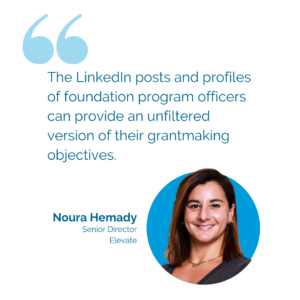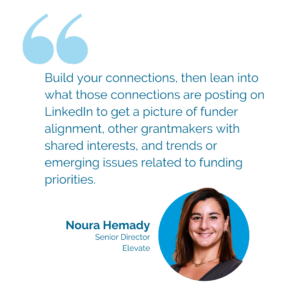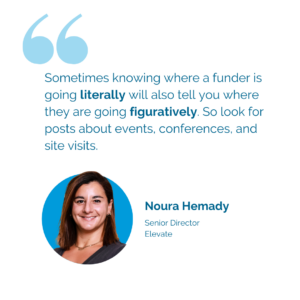Over the course of 20+ years, LinkedIn has become a compulsory tool that helps its 1 billion members build their professional networks and access new career opportunities. But did you also know that LinkedIn can play a vital role in helping nonprofits better meet their fundraising goals—specifically by helping them to learn more about what is important to grantmakers as well as how funders are evolving their priorities?
If not, let us fill you in! To tell us more about how LinkedIn can complement more traditional research tools like Candid’s Foundation Directory Online, we spoke with one of Elevate’s Senior Directors of Institutional Fundraising, Noura Hemady. We like to call Noura our LinkedIn Sleuth precisely because she has engineered a unique approach to supplementing more traditional means of funder research with what she is able to glean from her extensive LinkedIn network. She makes it a habit to peruse Linkedin regularly “like some people read the Washington Post or the New York Times” (coffee included). And because a LinkedIn feed is an aggregate, it is like one stop-shopping, so as little as 10 minutes a day can reveal a lot of news.
To help you get started, Noura generously shared the following five introductory tips for nonprofits seeking to unlock opportunities via LinkedIn.
Tip #1: Follow the funder’s people
It’s great to follow LinkedIn company pages, but it’s better to think beyond them. Specifically, take that extra step on LinkedIn and find out who is associated with the funder, and follow these individuals as well. This includes foundation leaders and staff, as well as their media accounts and consultants—don’t be shy! In this way, you will create a strong network to mine for additional information that you may not be able to access in other ways (per Noura’s other tips).
Tip #2: Assess what is getting posted, reposted, and liked
 Once you have built out your connections, lean into what those connections are posting. This includes likes and reposts by program officers and foundation leadership. From there, you can begin to get a clearer picture of foundation alignment—who do they consider to be a part of their affinity group of foundations with shared interests, and what thought leaders, trends, or emerging issues do they deem relevant when it comes to their funding priorities? You may also find potentially aligned funders that you didn’t previously know about — and use traditional research tools to uncover more.
Once you have built out your connections, lean into what those connections are posting. This includes likes and reposts by program officers and foundation leadership. From there, you can begin to get a clearer picture of foundation alignment—who do they consider to be a part of their affinity group of foundations with shared interests, and what thought leaders, trends, or emerging issues do they deem relevant when it comes to their funding priorities? You may also find potentially aligned funders that you didn’t previously know about — and use traditional research tools to uncover more.
For example, one of Noura’s nonprofit clients was looking for a way to revive their relationship with a former funder when she noticed that the funder posted a feature story about her client on LinkedIn. Noura advised the client to view this as a timely opportunity to re-engage with the funder by sending a thank you and an update on the organization’s work.
Tip #3: Read beyond official communications
 Funder websites are filtered through communications strategies and jargon. As a result, sometimes the highly polished statements of funding priorities and goals found on these official sites are a bit vague and hard to discern. To access a less filtered version of the funder’s agenda and objectives, you can see how program officers are talking about their work at the foundation in their own words via their LinkedIn posts and profiles. Taken alongside reposts and likes, this may help you read between the lines and make a better case for alignment (or alternatively, comprehend if you are not aligned).
Funder websites are filtered through communications strategies and jargon. As a result, sometimes the highly polished statements of funding priorities and goals found on these official sites are a bit vague and hard to discern. To access a less filtered version of the funder’s agenda and objectives, you can see how program officers are talking about their work at the foundation in their own words via their LinkedIn posts and profiles. Taken alongside reposts and likes, this may help you read between the lines and make a better case for alignment (or alternatively, comprehend if you are not aligned).
Tip #4: Take notice of funder meetings and webinars
 Sometimes knowing where a funder is going literally will also tell you where they are going figuratively. So look for posts about events, conferences, and site visits. These may also inform you about who their grantees are and which organizations they consider to be peers, partners, or otherwise aligned.
Sometimes knowing where a funder is going literally will also tell you where they are going figuratively. So look for posts about events, conferences, and site visits. These may also inform you about who their grantees are and which organizations they consider to be peers, partners, or otherwise aligned.
You also might learn about helpful webinars or virtual events that funders are hosting or attending. For instance, after Noura discovered via LinkedIn that a funder was planning to host a webinar on how to tap into donor-advised funds, her client was able to attend and learn some helpful cultivation tips.
Tip #5: Pay attention to jobs and requests for proposal postings
This is your chance to look into the crystal ball! Before a new portfolio or grantmaking strategy appears on a funder’s website, you might just see hiring posts for new advisors or program officers on LinkedIn first. Similarly, you might get an early glimpse of an RFP or other funding announcements.
For example, Noura noted that a high-profile family foundation posted on LinkedIn about a new program officer position focused on the U.S. South. This position had not yet been posted on the funder’s website. Accordingly, she provided her client with a preview of this new geographic focus.
In another case, a LinkedIn contact Noura was following reposted information about an RFP for expansion into Los Angeles by a new-to-her San Francisco-based funder. She used this information to give her four Los Angeles-based clients a heads up, as each of them had eligible projects. One of these organizations subsequently secured $25,000 in new funding.
So what are you waiting for? Get to sleuthing! It may take some time to build out your Linkedin network in this way, but by following these simple tips, you may reap the dividends!
Also, we’d love to hear from you! Tell us a) if you have any Linkedin fundraising practices that have worked well for you or b) about the results of putting into practice the tips we have suggested here.
Relatedly, please be sure to check out our advice on why you should cultivate relationships with funders. And keep an eye on this space for more tips from Elevate’s fundraising experts!
About the Authors:

Johnisha Levi

Noura Hemady










 Once you have built out your connections, lean into what those connections are posting. This includes likes and reposts by program officers and foundation leadership. From there, you can begin to get a clearer picture of foundation alignment—who do they consider to be a
Once you have built out your connections, lean into what those connections are posting. This includes likes and reposts by program officers and foundation leadership. From there, you can begin to get a clearer picture of foundation alignment—who do they consider to be a  Funder websites are filtered through communications strategies and jargon. As a result, sometimes the highly polished statements of funding priorities and goals found on these official sites are a bit vague and hard to discern. To access a less filtered version of the funder’s agenda and objectives, you can see how program officers are talking about their work at the foundation in their own words via their LinkedIn posts and profiles. Taken alongside reposts and likes, this may help you read between the lines and make a better case for alignment (or alternatively, comprehend if you are not aligned).
Funder websites are filtered through communications strategies and jargon. As a result, sometimes the highly polished statements of funding priorities and goals found on these official sites are a bit vague and hard to discern. To access a less filtered version of the funder’s agenda and objectives, you can see how program officers are talking about their work at the foundation in their own words via their LinkedIn posts and profiles. Taken alongside reposts and likes, this may help you read between the lines and make a better case for alignment (or alternatively, comprehend if you are not aligned). Sometimes knowing where a funder is going
Sometimes knowing where a funder is going 





